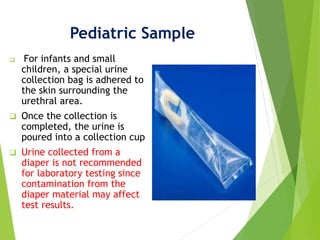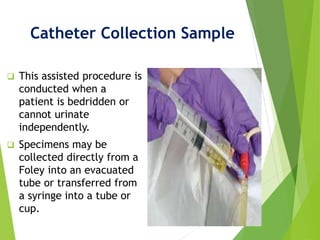practical 1.pptx
- 1. Neonatal blood sampling (heel prick) Purpose and indications The neonatal heel prick is a common procedure for taking a blood sample from the heel of newborn which is used for a variety of tests, such as Bilirubin and TSH. Site The recommended location for blood collection on a newborn baby or infant is the heel, only lateral parts are used not central part to avoid medial calcaneus nerve, injury to this nerve can cause necrotizing osteochondritis.
- 2. Procedure 1. Clean the site to be punctured with warm water sponge 2. Hold the baby's foot firmly to avoid sudden movement and to apply slight tension to the skin. 3. Using a sterile blood lancet, puncture the heel. 4. Wipe away the first drop of blood with a piece of clean, dry cotton 5. Collect blood sample using test tube, capillary tube, or automatic pipette. 6. When finished, elevate the heel, place a piece of clean, dry cotton on the puncture site, and hold it in place until the bleeding has stopped.
- 5. introduction Why urine analysis is done? o As a general evaluation of health. o To screen for a disease or infection of the urinary tract. o To monitor the treatment of certain conditions such as kidney stones, a urinary tract infection (UTI) o Diagnosis of some metabolic and endocrine disturbances in the body such as diabetes. Symptoms and conditions that require urine test; o Discolored or foul-smelling urine o Pain during urination o Blood in the urine (hematuria) o Frequent urination, abdominal pain, or back pain Pregnant women to chick the risk of pregnancy toxemia
- 6. Type of urine samples Laboratory urine specimens are classified by the type of collection conducted or by the collection procedure used to obtain the specimen. Random Sample First Morning Sample Midstream Sample Timed Collection Sample Catheter Collection Sample Suprapubic Aspiration Sample Pediatric Sample
- 7. Random Sample This is the specimen most commonly sent to the laboratory for analysis usually submitted for urinalysis and microscopic analysis Although there are no specific guidelines for how the collection should be conducted, avoiding the introduction of contaminants into the specimen is recommended. This requires explicit instructions to patients so that they do not touch the inside of the cup or cup lid.
- 8. First Morning Sample Why the first voided morning specimen is preferred? ► Because it is usually more concentrated and therefore more likely to reveal abnormalities. ► This is usually hypertonic and reflects the ability of the kidney to concentrate urine during dehydration which occurs overnight. Precautions ► All samples should be midstream and collected in a clean sterile container. ► Avoid touching the inside or rim of the container with your fingers or genital area.
- 9. Midstream Sample ► Clean the area around your genitals. ► Begin urinating into the toilet. ► After the urine has flowed for several seconds, place the collection container into the stream and collect this midstream urine without interrupting the flow. ► Finish urinating into the toilet. ► Carefully replace the lid on the container and return it to the lab.
- 10. Pediatric Sample For infants and small children, a special urine collection bag is adhered to the skin surrounding the urethral area. Once the collection is completed, the urine is poured into a collection cup Urine collected from a diaper is not recommended for laboratory testing since contamination from the diaper material may affect test results.
- 11. Catheter Collection Sample This assisted procedure is conducted when a patient is bedridden or cannot urinate independently. Specimens may be collected directly from a Foley into an evacuated tube or transferred from a syringe into a tube or cup.
- 12. Suprapubic Aspiration Sample This method is used when a bedridden patient cannot be catheterized or a sterile specimen is required. The urine specimen is collected by needle aspiration through the abdominal wall into the bladder.
- 13. Precautions for urine analysis: - ـ The ideal situation is when the specimen is analyzed shortly after collection (within 1h). ـ If examination can't be done directly after collection the sample must be refrigerated within 1 hour of collection. ـ If the specimen is not refrigerated within 1 hour of collection, ـ the following changes in composition may occur: Increased pH from the breakdown of urea to ammonia by urease-producing bacteria) Decreased glucose from glycolysis and bacterial utilization Decreased ketones because of volatilization Decreased bilirubin from exposure to light Increased bacteria from bacterial reproduction Increased nitrite from bacterial reduction of nitrate Precipitation of amorphous urates. Changes in color caused by oxidation or reduction of metabolites Increased turbidity caused by bacterial growth and precipitation of amorphous material Disintegration of red blood cells (RBCs) and casts, particularly in dilute alkaline urine
- 14. Preservation of urine: Urine specimens should not remain un-refrigerated for longer than two hours. Refrigeration will slow microbial growth and tends to stabilize most urine components for up to 12 hours. Note: you must re-warm the sample before analysis. Urine sample rejection: Generally specimens that could lead to false interpretation should be rejected such as: The sample must be sufficient quantity {the widely accepted urine volume is 12 ml}. Specimens that is contaminated from a woman's menstrual period. Not getting urine sample to lab in 2 hour. Urine sample that is taken in dirty container. Specimens that is contaminated with feces.
- 15. Timed Collection Sample A timed specimen is collected to measure the concentration of these substances in urine over a specified length of time, usually 8 or 24 hours. Among the most commonly performed tests requiring timed specimens are those measuring creatinine, total protein. In this collection method, the bladder is emptied prior to beginning the timed collection. The specimen should be refrigerated during the collection period, unless otherwise requested by the physician. Urine collection containers for 24-hour specimens commonly have a 3 liter capacity.
- 16. Sampling for total protein in urine Overview: o The urine protein test measures the amount of protein being excreted in the urine. o The quantity of protein in a 24-hour urine sample are measured and reported as the amount of protein excreted per 24 hours. Why it is done? 1. If two or more urinalyses are positive for protein. 2. To evaluate and monitor kidney function. 3. To help detect and diagnose early kidney damage and disease.
















